A Guide to the Towers of Silence in Yazd, Iran
Imagine a world where fire, water, earth, and air are held sacred, and the natural world is seen as a canvas for the divine.
This is the essence of Zoroastrianism, one of the world's oldest religions, practiced in Iran for millennia. At the heart of this belief lies a deep respect for the purity of nature, which manifests in unique ways, including their funerary practices. Enter the Towers of Silence – ancient, enigmatic structures that dot the Iranian landscape, whispering tales of a fascinating culture and its reverence for the circle of life.
Interested in visiting the Towers of Silence in Yazd?
Check out our Yazd tour packages to find an itinerary that includes visiting the towers
or...
Design your own tailor-made itinerary and include the Towers of Silence in it by yourself, today!
Origins of the Towers of Silence
The origins of the Towers of Silence can be traced back to ancient Zoroastrian traditions, believed to have emerged over 3,000 years ago in Persia, present-day Iran. These elevated circular structures served as sacred sites for the exposure of the deceased, aligning with Zoroastrian beliefs that emphasized purity, respect for the elements, and the sanctity of the earth. The concept of the Towers evolved as a way to maintain spiritual cleanliness while allowing the natural elements to decompose the body, preventing pollution of the earth, fire, and water.
Zoroastrian Beliefs and Practices

In Zoroastrianism, death was viewed as a temporary state where the soul transitioned to the afterlife. The religion advocated for purity in life and death, considering the elements of earth, fire, and water as sacred. Zoroastrians believed that burying or burning the dead could potentially contaminate these elements, hence opting for the ritual of exposing the deceased atop the Towers of Silence. This practice aligned with their reverence for nature and the principles of purity.
| Read more: Top 14 Religious Tourist Attractions in Iran
Evolution of the Towers
Over centuries, the Towers of Silence evolved in design and cultural significance. Initially simple structures, they developed into more elaborate constructions, reflecting architectural advancements while retaining their spiritual importance. These sites became integral to Zoroastrian funeral rituals, symbolizing the passage of the soul to the spiritual realm. The cultural significance of these towers extended beyond their religious role, becoming iconic symbols of ancient Persian culture and heritage, embodying the unique blend of spiritual beliefs and architectural prowess. Their presence remained a testament to the enduring legacy of Zoroastrianism in Iran's history and cultural identity.
Towers of Silence Architecture and Design
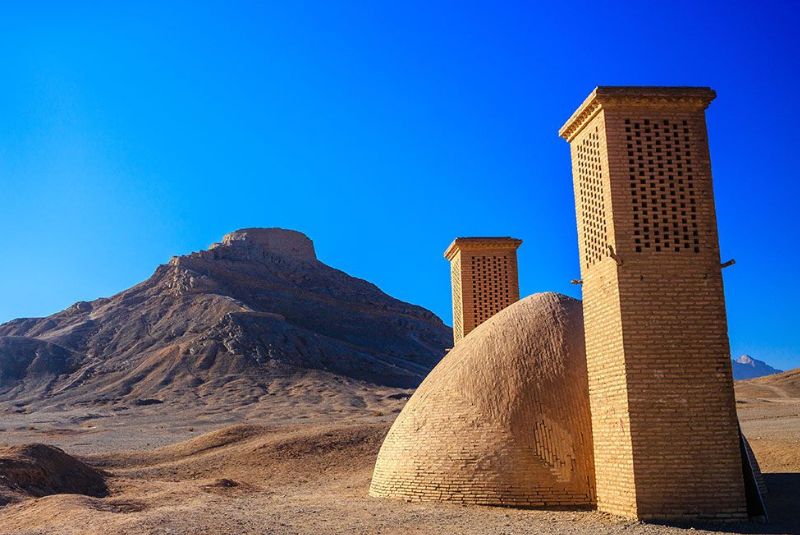
The Towers of Silence typically comprise circular, raised structures constructed on hilltops or elevated areas. These towers were built using stone, mud brick, or other locally available materials. They consist of concentric rings or walls forming several levels, often divided into three distinct rings. The outer ring served as a boundary, while the inner rings contained individual compartments or open-air spaces for placing the deceased.
The construction of Towers of Silence involved meticulous planning and adherence to Zoroastrian religious principles. The layout incorporated a central pit or well where the bodies were placed, allowing nature, through exposure to the elements and scavenger birds, to decompose the flesh. The towers were built in a way to facilitate this process while containing the remains within the structure. The design aimed to ensure the purification of the soul and prevent contamination of the natural elements.
Symbolism played a significant role in the architecture of the Towers of Silence. The circular shape symbolized the cyclical nature of life, death, and rebirth, mirroring the Zoroastrian belief in eternal cosmic order. The elevated location signified the connection between earth and sky, facilitating the transition of the soul to the spiritual realm. Additionally, the division of the towers into concentric rings reflected the sacred separation of the deceased and the progression of the decomposition process.
| Related: Fire Temple - The Holy Places Where Zoroastrians Worship God
The Structure of the Towers of Silence
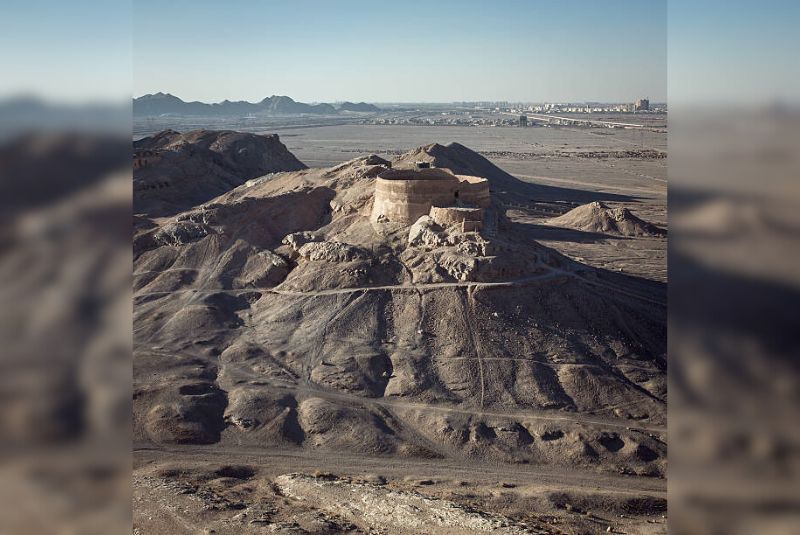
While the imposing circular shape of the Towers of Silence is their most striking feature, these ancient structures hold fascinating intricacies within their walls. Let's dive deeper and explore the different parts that make up a Tower of Silence:
1. The Central Well
At the heart of every Tower of Silence lies a deep, central well. This well functioned as the final resting place for the deceased, receiving the bones after the flesh was stripped by vultures. Often lined with stone or brick, the well symbolized the connection between the physical body and the earth below, reminding observers of the natural cycle of life and death.
2. Concentric Rings
Surrounding the central well are concentric rings, like ripples on a still pond. These rings served a practical purpose - providing designated areas for laying out the bodies of the deceased. Traditionally, these rings followed a gendered hierarchy, with the outer ring reserved for men, the middle for women, and the innermost for children. This arrangement reflected the Zoroastrian belief in the purity of women and children.
3. Stone Beds
Each ring contained elevated stone beds, often called "sarbeds." These beds, usually sculpted from durable stone, provided a clean and elevated platform for the body to be placed. Their raised position ensured efficient exposure to the elements and carrion birds, facilitating the natural decomposition process.
4. Drainage Channels
To prevent rainwater from accumulating and potentially contaminating the earth, the Towers of Silence incorporated clever drainage channels. These channels, often carved into the stone beds or integrated into the structure's walls, directed rainwater away from the central well and towards designated drainage points.
5. Peripheral Walls
Encircling the entire structure is a sturdy outer wall. Constructed from sturdy brick or stone, this wall served several purposes. It prevented animals from entering and disturbing the bodies, maintained the circular shape of the tower, and offered a sense of enclosure and sanctity to the sacred space within.
6. Entrance Pathway
A narrow ramp or pathway led up to the rooftop platform of the Tower of Silence. This pathway allowed authorized individuals, such as the nasusalar priests, to access the platform for placing the bodies and performing necessary rituals. The restricted access emphasized the sacred nature of the space and limited potential disturbances.
7. Rooftop Features
The rooftop of the Tower of Silence, beyond the concentric rings, sometimes held additional features. Some towers included prayer stones or altars where mourners could offer final prayers before leaving their loved ones to the natural elements. In some cases, small structures might have been built to house tools or materials needed for the rituals.
| Suggestion: Chak Chak Zoroastrian Pilgrimage Site in Yazd
Towers of Silence Function and Purpose
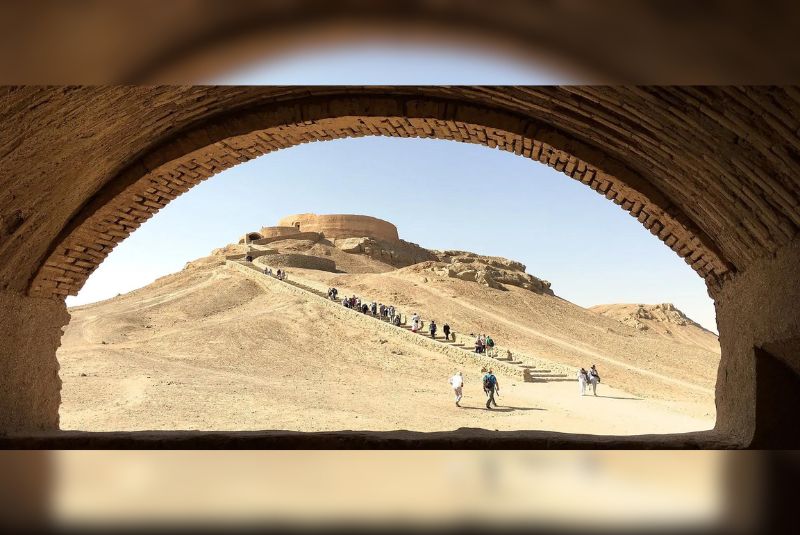
The Towers of Silence played a central role in Zoroastrian funeral rituals. When a person passed away, their body was not buried or cremated but taken to the Tower of Silence. Here, the body underwent a sacred process of exposure to the elements, primarily the sun and scavenger birds, as per Zoroastrian tradition. This practice was deeply rooted in the belief that the physical body was impure after death and needed to be purified before the soul departed to the afterlife.
Upon arrival at the Tower of Silence, the body was placed atop the structure, exposed to the elements and the sun. The scavenger birds, primarily vultures, played a crucial role in the decomposition process. They would consume the flesh, aiding in the swift decomposition of the body. This process, known as excarnation, allowed the bones to be bleached by the sun and wind, eventually disintegrating or falling into the central well of the tower.
The entire ritual was rooted in the principles of purity, respecting the elements of earth, fire, water, and air. It symbolized the cycle of life, death, and rebirth while emphasizing the importance of maintaining harmony with nature and the cosmos.
| Related: Naqsh-e Rustam - Achaemenid, Sassanid, and Zoroastrian Legacy
Cultural and Religious Significance of the Towers
The Towers of Silence held profound significance in shaping and preserving Zoroastrian beliefs and funeral practices. These structures were intrinsic to the religious rituals surrounding death and the afterlife, reinforcing the principles of purity, respect for nature, and the sanctity of the elements. They served as physical manifestations of spiritual beliefs, influencing the way Zoroastrians approached death, burial customs, and the transition of the soul.
Towers of Silence Location and Accessibility
The Towers of Silence are situated in various regions across Iran, notably in locations such as Yazd, Kerman, and other historically significant areas. The most well-known are located in Yazd, a UNESCO World Heritage City renowned for its Zoroastrian heritage. Accessibility to these sites varies, with some easily accessible by road while others might require guided tours or local assistance due to their remote locations. Visitors can reach these sites via public transportation, guided tours, or private vehicles.
Visiting the Towers
Visiting these sites requires mindful preparation and respect for local customs. Here are some essential tips:
- Dress modestly: Cover your shoulders and knees, and avoid revealing clothing.
- Be mindful of your behavior: Speak softly, avoid taking photos of mourners, and refrain from touching the towers or any religious objects.
- Seek permission: Obtain permission before entering the towers themselves.
Beyond the Towers
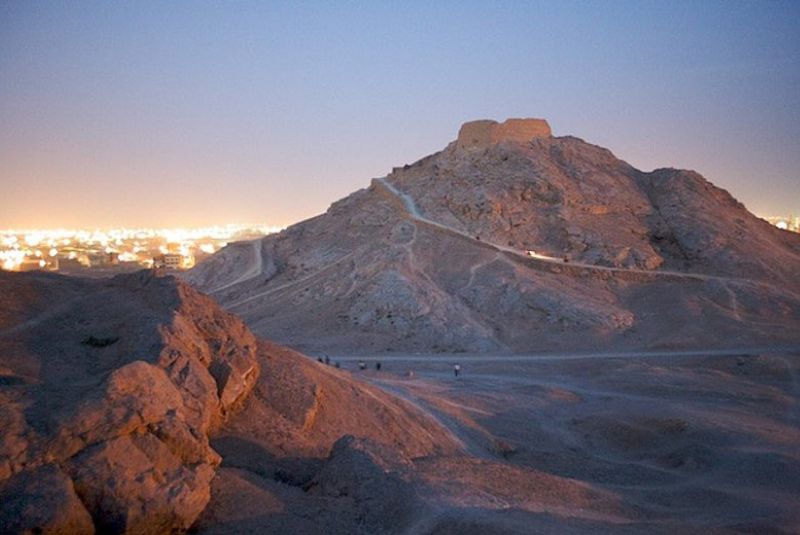
Your journey into Zoroastrian culture doesn't have to end at the Towers of Silence. Yazd itself offers a treasure trove of Zoroastrian heritage, from the majestic Jameh Mosque and the fascinating Zoroastrian Fire Temple to the Yazd Water Museum, showcasing the city's ingenious water management systems.
Let's explore the structures surrounding the Towers of Silence:
Ritual Houses
Nestled around 150-200 meters north of the Dakhmas stand several buildings constructed from mudbrick, stone, and brick. These are the ritual houses, where mourners would gather before and after the body was placed in the Towers of Silence. Often two-storied with multiple rooms, they provided a space for families to perform final rituals, wash the deceased, and offer prayers.
Ossuaries
Within or near the ritual houses, you might find ossuaries – small, stone structures used to store the bones of the deceased after they were cleaned by vultures in the Dakhmas. These ossuaries, often adorned with intricate carvings, served as final resting places for the bones, showcasing the Zoroastrian belief in the sanctity of the human body even after death.
Water Cisterns
Given the arid climate of Yazd, water was a precious commodity. To ensure ritual purity, the Zoroastrians built cisterns near the Towers of Silence. These underground structures collected rainwater, which was used for washing the deceased and performing cleansing rituals. Some cisterns even featured intricate filtration systems, highlighting the Zoroastrian emphasis on hygiene and respect for the environment.
Caretaker Quarters
Maintaining the sanctity of the Towers of Silence and surrounding structures required constant vigilance. Hence, caretaker quarters were often built nearby. These modest dwellings housed individuals responsible for upkeep, ensuring the ritual houses, ossuaries, and cisterns remained functional and clean.
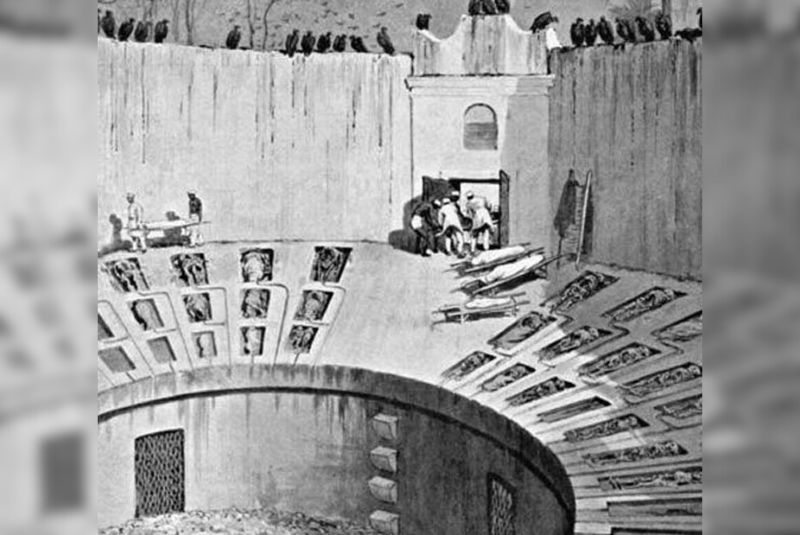
Whispers from the Towers of Silence
Visiting the Towers of Silence in person is an experience that resonates long after you depart. Standing beside the imposing Towers of Silence, bathed in the golden light of the setting sun, a sense of awe washes over you. These ancient structures, silent sentinels on the dusty plains, hold within them centuries of tradition, whispers of a culture deeply intertwined with nature and reverence for the cycle of life.
Share your story!
Comment below and let us know about your Experience.
Your story inspires others!


Comment
Leave a Comment